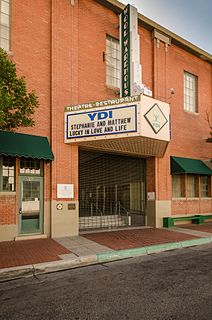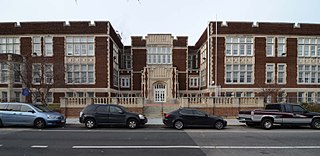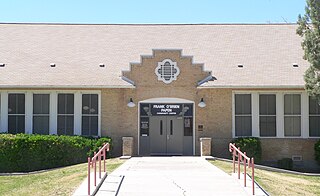
The Old Albuquerque High School is the historic former campus of Albuquerque High School in Albuquerque, New Mexico. It is located in the Huning Highlands neighborhood and is protected by the city as a historic landmark. It is located on the northeast corner of Central and Broadway NE, at the center of an area that has become known as East Downtown or EDo. The campus comprises five buildings, the oldest of which was built in 1914. After the school moved to a new location in 1974, the old buildings were left abandoned for decades before being renovated as loft apartments in the early 21st century. Old Albuquerque High was added to the New Mexico State Register of Cultural Properties in 1977.

The Myrtle Street School is a historic school at 64 Myrtle Street in the Indian Orchard neighborhood of Springfield, Massachusetts. Built in stages between 1868 and 1915, it encapsulates changing trends in school design over that period of time, and is a good example of a school building with Second Empire and Classical Revival features. It was listed on the National Register of Historic Places in 1985. It has been converted to residential use.

The Main Building of Torrance High School is located on the campus in Torrance, southwestern Los Angeles County, California. The Main Building was opened to students as Torrance School in 1917.

The Greenfield Union School is a school located at 420 West 7 Mile Road in Detroit, Michigan. A part of Detroit Public Schools (DPS), the school building was listed on the National Register of Historic Places in 2011.

The Wool Warehouse is a historic building in the Warehouse District of downtown Albuquerque, New Mexico. Built in 1928–29 by wool merchant Frank Bond, the warehouse is significant for its role in New Mexico's wool industry in the mid-20th century. It was added to the New Mexico State Register of Cultural Properties in 1980 and the National Register of Historic Places in 1981.
Tjalke Charles Gaastra was an American architect who worked in the American southwest in the first half of the twentieth century. He won the International Exhibit of Architecture in Berlin for the Gildersleeve house in Santa Fe, New Mexico which he designed for New Mexico Supreme Court justice, David Chavez. Gaastra was a major player in the Spanish Pueblo Revival architectural style in Santa Fe, New Mexico.

The Janney Elementary School is a public elementary school from Pre-K through 5th grade. A part of the District of Columbia Public Schools, it enrolls approximately 740 students.

Nob Hill is a neighborhood in Albuquerque, New Mexico, consisting of a commercial district along Central Avenue and surrounding residential areas. Located just east of the University of New Mexico, the neighborhood was developed between about 1925 and 1950 and has since become a popular tourist and shopping destination. Known for its eclectic mix of mostly locally owned businesses, Nob Hill has been described as "the heart of Albuquerque's Route 66 culture and also its hippest, funkiest retail and entertainment district". The neighborhood is named after Nob Hill in San Francisco.

Bruce-Monroe Elementary School at Park View is a bilingual elementary school in Washington, D.C. Named after Blanche Bruce and James Monroe, it has been located in the historic Park View School in the city's Park View neighborhood since 2008. It is part of the District of Columbia Public Schools.

Carlisle Gymnasium is an indoor arena on the campus of the University of New Mexico in Albuquerque, New Mexico. It was the home of the New Mexico Lobos basketball team from its opening in 1928 until the completion of the larger Johnson Gymnasium in 1957, and was also the original venue of the New Mexico Symphony Orchestra. The building currently houses the university's Elizabeth Waters Center for Dance.

Hodgin Hall, previously known at various times as the University Building, Main Building, or Administration Building, is a historic building on the University of New Mexico campus in Albuquerque, New Mexico. Completed in 1892, it was the first building constructed on the UNM campus and the university's only building for almost a decade. The building was originally designed by Jesse Wheelock in the Richardsonian Romanesque style, but structural problems with the building's roof gave university president William Tight the opportunity to have it remodeled in his preferred Pueblo Revival style in 1908.

The Hendren Building is a historic commercial building in the Nob Hill neighborhood of Albuquerque, New Mexico. Built in 1946, it is one of the city's most notable examples of Streamline Moderne architecture, and representative of the boom in automobile-oriented commercial development in the immediate post-war period. The building was one of the last completed works by architect T. Charles Gaastra. It was added to the New Mexico State Register of Cultural Properties in 1999 and the National Register of Historic Places in 2000.

The Santa Barbara School is a historic school building in the Martineztown-Santa Barbara neighborhood of Albuquerque, New Mexico. Built in phases between 1908 and 1930, it is one of the city's oldest surviving school buildings and is notable for its association with Atanasio Montoya, a noted educator who reformed and modernized the Bernalillo County school system in the early 20th century. The school was added to the New Mexico State Register of Cultural Properties and the National Register of Historic Places in 1989.

The Employees' New Dormitory and Club, also known as Building 232, is a historic building in Albuquerque, New Mexico. Built in 1931, it is notable as the only surviving building of the Albuquerque Indian School, which operated at this location from 1882 to 1976. It was added to the New Mexico State Register of Cultural Properties in 1981 and the National Register of Historic Places in 1982.

West San Jose School, also known as Riverview School, is a historic former elementary school in the Barelas neighborhood of Albuquerque, New Mexico. It was built in 1936–37 as a Works Progress Administration project and operated as a school until 1975. It is now part of the National Hispanic Cultural Center. The building was added to the New Mexico State Register of Cultural Properties and the National Register of Historic Places in 1996.

Monte Vista Fire Station is a historic former fire station in the Nob Hill neighborhood of Albuquerque, New Mexico. Built in 1936 using Works Progress Administration funding, it is notable as a well-preserved WPA municipal project and for its significance in the early development of the Nob Hill area. The building served in its original role as a fire station until 1972 and currently houses a restaurant. It is the city's third oldest surviving fire station after the AT&SF Fire Station, built in 1920, and the old station #2 on the corner of High St. and Silver Ave. opened in 1926.

Scholes Hall is the historic administration building of the University of New Mexico, located on the main campus in Albuquerque. It was the first of many buildings designed for the university by Santa Fe architect John Gaw Meem, who helped to cement the Pueblo Revival style as the "official" architecture of the campus. Built in 1934–36 with Public Works Administration funding, it is regarded as one of Meem's most notable designs.

Martineztown-Santa Barbara is a neighborhood in central Albuquerque, New Mexico, immediately northeast of Downtown. Originating as a small farming village in the 1850s, it is one of the city's oldest neighborhoods and retains a distinct character, with winding streets, irregular lots, and adobe vernacular buildings reminiscent of other old Hispanic communities in northern New Mexico.

Huning Highlands, also known as EDo or East Downtown, is an inner-city neighborhood in Albuquerque, New Mexico, directly east of Downtown. It is a mostly residential area known for its high concentration of Victorian and early 20th-century houses and is listed on the National Register of Historic Places as the Huning Highlands Historic District. There is also a commercial district along the main thoroughfares, Central Avenue and Broadway Boulevard. Huning Highlands was developed starting in 1880 and is named for Franz Huning, a prominent businessman at the time.

The Mesilla Park Elementary School, in Las Cruces, New Mexico, was listed on the National Register of Historic Places in 2015.






















